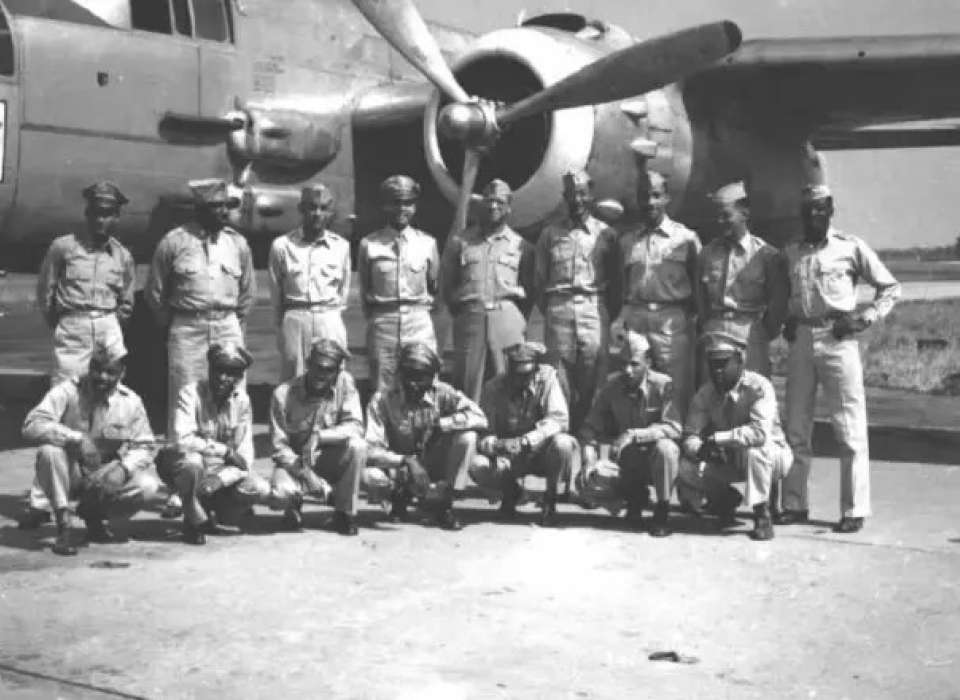Top image: 477th Bomb Group members in front of a B-25. (USAF Photo)
Most of us are well aware of the bravery and accomplishments of the 332nd Fighter Group, often referred to as “The Red Tails.” Flying fighter aircraft in the Mediterranean, the 332nd served with distinction conducting fighter escort for the Fifteenth Air Force bombers. However, less well known is the 477th Bombardment Group that was the first Black bombardment unit in Air Force history. Training in twin engine B-25 “Mitchell” bombers, the 477th never actually saw combat overseas, but fought another battle here in the United States. Formed as an all-Black unit, it became famous not for its combat record, but for its fight against the military version of “separate but equal.”
The unit was officially established on June 1, 1943, but was formally activated on January 15,1944, under the command of Colonel Robert Selway. As the unit formed, its senior leadership was white while the trainee aircrews were black. This distinction would have ramifications. Starting at Selfridge Field, Michigan, the unit’s climate was quickly established when the Commanding General of the First Air Force, Major General Frank “Monk” Hunter, addressed the command and stated, “The War Department is not ready to recognize Blacks on the same level of social equal to white men…I will not tolerate any mixing of the races…” This quote foreshadowed the unit’s experiences with racism over the coming year.
In May 1944, the unit was transferred to Gorman Field, Kentucky, which was collocated with Fort Knox. The social mixing of Black and white officers was avoided as the location had separate officer club facilities: White officers went to Fort Knox while Black ones stayed at Gorman Field. Later, in March 1945, the unit was relocated to Freeman Field, Indiana, which was much larger and could house all four of the group’s squadrons. However, unlike Gorman Field, there was only one officer’s club in the area. Despite Army Regulation 2-10 that specified that an officer at a base was entitled to join the officers club, Selway established two officer’s clubs at the new location. Instead of labeling them for “Black” or “white” officers, he thinly veiled his racism by designating one for “base and supervisory personnel” and the other for “trainees.” With “supervisory personnel” being white officers and the “trainees” typically Black, Selway attempted to institute segregationist policies. It did not take much time before the “trainee” club was given the derisive moniker “Uncle Tom’s Cabin” with Black officers refusing to use it. Upset at their treatment, a meeting of the Black officers resulted in a planned, non-violent stand against the two-club situation. In groups of five, the officers planned to enter the “supervisory” facility, one group shortly followed by another. On April 5, 36 officers attempted to enter the “supervisory” club, claiming that the title indeed applied to them, and pushed their way past the Base Provost Marshall. The following day, 25 officers again attempted to gain access. Eventually all 61 officers were arrested and charged with disobeying a superior officer. All the charges were eventually dropped, except for three officers who were charged with violent activity while attempting to shove a white officer aside.
To address the situation while still attempting to enforce segregationist policies, Selway published Base Regulation 85-2 that outlined “who” could use “what” recreational facilities on base. A violation of the regulation was a chargeable offense. With over 400 black officers at the base, most of them signed this order recognizing its authority—although many objected. However, 101 members of the 477th and the Air Force base unit refused to sign and were subsequently arrested for insubordination. Forty-two of these 101 officers had previously been charged in the earlier incidents of April 5–6. On April 13, the 101 officers were flown to their old base at Goodman Field and placed under house arrest. However, word spread about these men in the Black press and the halls of the War Department. Given the increased visibility of the situation, MG Hunter intervened and ordered their release, but not before Selway issued them all administrative reprimands.
Shortly after, the 477th was moved back to Gorman Field, where two officers’ clubs existed and served to avoid any future complications. However, on May 18, a War Department committee determined that Selway’s Base Regulation 85-2 violated the Army’s 2-10 Regulation and seemingly exonerated the Black officers. Selway was eventually relieved of command and replaced with Colonel Benjamin Davis, who previously commanded the 332nd Fighter Group. With the addition of fighters to the unit, the 477th was renamed a “Composite Group” and was staffed with only Black officers, with all white ones reassigned elsewhere. Eventually the unit was directed to Lockbourne Field (later Air Force Base) near Columbus, Ohio, in 1947. With the establishment of the US Air Force in 1947, the base remained the only Black Air Force base in history with all-Black groups, wings, and squadrons. This structure remained in place until mid-1949 when the Air Force finally implemented President Harry Truman’s 1948 Executive Order 9981 that ended segregation of the armed services.
Of the three officers charged with violence in the April 5 incident, they stood court-martial on July 2–3, 1945. Two were exonerated, with the third receiving a light sentence given the charges. However, in 1995 this singular conviction was set aside. The reprimands for the other officers involved in the mutiny were removed from their records if requested. However, some did not ask for their removal as they saw these remarks as a proud legacy of fighting institutional racism. Historically, the results of the mutiny were a mixed bag. While the charged officers were exonerated, segregation was still enforced and the military version of “separate but equal” remained the status quo until Truman’s decisive action.
John Curatola, PhD
John Curatola, PhD, is the Samuel Zemurray Stone Senior Historian at the Jenny Craig Institute for the Study of War and Democracy.
Cite this article:
MLA Citation:
APA Citation:
Chicago Style Citation:






![Max Fuchs, New York City cantor, sings as Rabbi Sydney [sic] Lefkowitz, Richmond, VA, conducts the first Jewish services from Germany.](/sites/default/files/styles/max_650x650/public/2025-10/image1.jpg)


